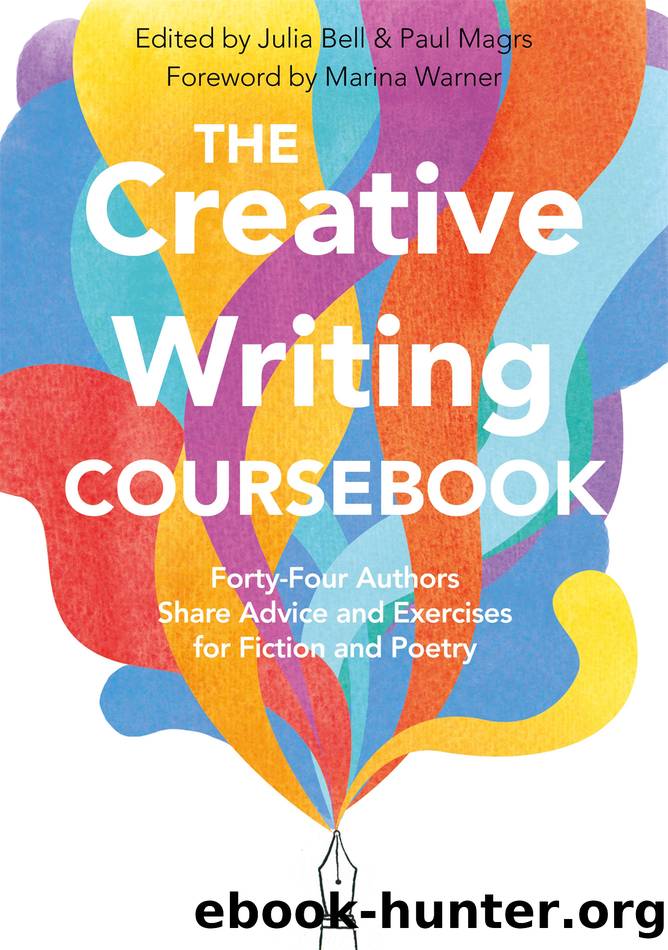The Creative Writing Coursebook by Julia Bell

Author:Julia Bell
Language: eng
Format: epub
Publisher: Pan Macmillan UK
Peaceful Symmetries: An Account of Teaching an Undergraduate Poetry Module at Queenâs University Belfast
Carol Rumens
Students often enrol for the creative writing course with the perception that writing poetry is all about âself-expressionâ. Without crushing their optimism, I try to refocus this expectation. Yes, the creative writing workshop is an arena for the play of individuality and imagination. There will be verbal opportunities unlikely to have been offered elsewhere on the curriculum, perhaps. And, yes, any piece of imaginative work will, ipso facto, express the self. At the same time, self-expression is not poetry. It is a by-product, a side effect. Poets learn, and often have to re-learn, that to concentrate on the self and those emotions for which lyric poetry apparently has a boundless appetite, is counterproductive as technique. This is not to banish the I but to emphasize that it is an âIâ. It is a construction, and its fables and reports must be re-made, reissued, fashioned in the image of language. Many of the students will come to the class with a sense of urgent things to say: this, after all, is Northern Ireland. They will have tried to get their emotions and ideas across, and they may have seen the emotions and ideas evaporate â or revolt. Fewer will be oppressed by a want of subjects to write about â those who are will probably have been mistaught that poetry has a specialized subject matter. But the issue we will most frequently address is shape. (The subject-matter question invariably looks after itself.) During the course of the poetry module we examine various set forms that have stood the test of ever-evolving linguistic and social contexts (often, in fact, migration and translation) and still retain their appeal for modem poets. These forms include the villanelle, triolet, sestina, sonnet, and haiku. In choosing which forms to present it was necessary to take into account their popularity: the better loved the form, the wider the range of interesting twentieth-century reworkings. We look at these texts in some detail. Reference works such as J. A. Cuddonâs Book of Literary Terms and Literary Theory and Peter Sansomâs Writing Poems will be consulted. Cuddon provides signposts to the historical origins of some of the forms, well worth following up in a longer course. With ten weeks only at our disposal, any deeper exploration a student may wish to make has to be undertaken independently.
Because the art of poetry is the art of speaking metaphorically, and of making linguistic objects that are themselves metaphors as well as metaphor-laden, the first âshapeâ we look at is that of the riddle. A good metaphorical riddle is like a cross section: it is a single-celled, relatively primitive kind of poem opened up, the organs and connective tissue laid bare. This connective tissue, in its inner and outer reaches, is all important. As the editors, Laurence Sail and Kevin Crossley-Holland, of The New Exeter Book of Riddles declare in their foreword, âTo say that an apple is not
Download
This site does not store any files on its server. We only index and link to content provided by other sites. Please contact the content providers to delete copyright contents if any and email us, we'll remove relevant links or contents immediately.
| Publishing & Books | Research |
| Writing |
Asking the Right Questions: A Guide to Critical Thinking by M. Neil Browne & Stuart M. Keeley(5577)
Autoboyography by Christina Lauren(5155)
Eat That Frog! by Brian Tracy(4386)
Dialogue by Robert McKee(4272)
Sticky Fingers by Joe Hagan(4064)
Journeys Out of the Body by Robert Monroe(3539)
Annapurna by Maurice Herzog(3398)
Full Circle by Michael Palin(3350)
Schaum's Quick Guide to Writing Great Short Stories by Margaret Lucke(3281)
Elements of Style 2017 by Richard De A'Morelli(3280)
The Art of Dramatic Writing: Its Basis in the Creative Interpretation of Human Motives by Egri Lajos(2946)
Why I Write by George Orwell(2851)
The Diviners by Libba Bray(2842)
In Patagonia by Bruce Chatwin(2830)
The Mental Game of Writing: How to Overcome Obstacles, Stay Creative and Productive, and Free Your Mind for Success by James Scott Bell(2819)
The Fight by Norman Mailer(2802)
Atlas Obscura by Joshua Foer(2762)
Venice by Jan Morris(2496)
The Elements of Style by William Strunk and E. B. White(2416)
